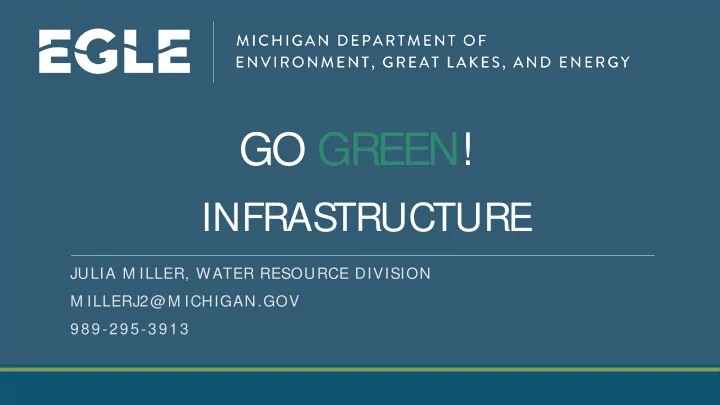

GO GREEN! INFRASTRUCTURE JULIA M ILLER, WATER RESOURCE DIVISION M ILLERJ2@M ICHIGAN.GOV 989-295-3913
OR M S 4 Small Communities
Presentation Outline 1. M unicipal Stormwater Regulatory Framework 2. Benefits of Stormwater M anagement for Small Communities (Grey & Green) 3. Cass River Small Community M S4 planning example 4. Guidance Documents
MS4 Framework 1. Illicit Discharge Elimination Program (IDEP) 2. Post Construction Controls (PCC) 3. Public Education Plan (PEP)
Identifying Sources of Stormwater Pollution 1. Get to know your system Identify outfalls Identify catch basins M ap system, if possible televising system Identify Green Infrastructure opportunities 2. Dry weather screening 3. Recognize illicit discharges and illegal dumping
Managerial Stormwater Controls 1. Adopt a LID Stormwater Ordinance to encourage and manage Green Development Site Plan Review Water Quality Treatment Performance Standard Channel Protection Performance Standard O&M Requirements for structural BM PS Enforcement Response Procedure 2. Asset M anagement Program Inspection and maintenance schedule Catch basin cleaning Street and parking lot sweeping
Structural Stormwater Controls 1. Catch basins 2. Curb and Gutter 3. Vegetated swales 4. Detention Basins/ Underground Storage 5. Infiltration Bio Swales Rain Gardens Pervious pavement
Public Education 1. Target audiences General Public (Kid vs. Adults) Industry/ Commercial 2. Delivery mechanisms Deliverables Internet/ Social M edia Presentations/ Displays TV/ Radio Broadcast
Benefits of Storm Water Management for Small Communities 1. Infrastructure Reduced maintenance Increase life span Ensure existing system is not over loaded by new development 2. Reduced flooding 3. Water Quality Improvements Reduce bacterial contamination Reduce algae blooms Reduce muddy water 4. Greenspace for Recreation/ Aesthetics Increase quality of life Increase recreation and tourism
Cass River Small Community MS4 planning 1. Frankenmuth M aster Plan 2. Watershed M anagement Plan – M S4 small community plans 3. What the plans covered 4. How to get started
Frankenmuth Master Plan 1. 1990s mapped entire system and determined flow capacities 2. M ade Cass River a Priority in 2005 M aster Plan 3. Cass River Greenways Committee formed 4. Cass River Watershed M anagement Plan 2014
Cass River Watershed Management Plan Urban Area Analysis Existing M anagerial Best M anagement Practices
Cass River Watershed Management Plan Urban Area Analysis Existing Structural Best M anagement Practices 1 Included two retention basins that use infiltration practices on their sites. 2 This number is high because of a discharge into a man-made lake with a lot of storage capacity; site could become a regional basin. 3 Frankenmuth has a long history of storm water management planning and a significant amount of development since the planning has been in effect. 4 Spicer Group designed one for a site in Caro; it was in residential area that was not surveyed. 5 M any sites did not have catchbasins on them; they were small areas and were graded to drain to the street storm drains or to an offsite drainage system. 6 Indicative of older vs newer development, the marked inlet grates did not make an appearance until after 2003, since approximately 2009 most inlet grates now have at least “ Dump No Waste” as part of the casting. Therefore if a community has 0% it probably indicates little to no new development.
How to Get started 1. Assess what is existing a) M aster Plan – Community Goals & Character b) Ordinances c) Stormwater system Structural M anagerial 2. Prioritize Recommendations 3. Identify Partners and technical resources 4. Identify Funding
Guidance Documents Filling the Gaps LID M anual for M ichigan Protecting M ichigan’s Inland Lakes: A Guide for Local Governments Tackling Barriers to Green Infrastructure: An Audit of Local Codes and Ordinances
Julia M iller, Environmental Quality Analyst millerj2@M ichigan.gov | 989-295-3913 800-662-9278 | Michigan.gov/EGLE
Recommend
More recommend